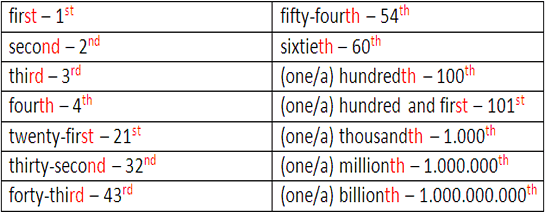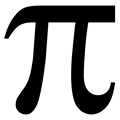Cardinal Numbers
- Em inglês os números entre 13 (thirteen) e 19 (nineteen) possuem a terminação -teen, que corresponde à sílaba tônica (a mais marcada na pronúncia) do número.
- Para formarmos os números maiores que vinte (twenty), colocamos primeiro as dezenas, seguidas das unidades. Utilizamos um hífen para unirmos as unidades às dezenas, tanto com os números cardinais como com os ordinais (Ex: 35- thirty-five, 167º- one hundred and sixty-seventh). Os números entre 20 (twenty) e 99 (ninety-nine) possuem terminação -ty e nunca terão esta sílaba como tônica.
Na lista a seguir, os números em vermelho são os que não seguem exatamente o padrão regular:
| 0- zero/ nought * | |||
1 - one
|
11 - eleven
|
21 - twenty-one
|
31 - thirty-one
|
2 - two
|
12 - twelve
|
22 - twenty-two
|
32 - thirty-two
|
3 - three
|
13 - thirteen
|
23 - twenty-three
|
33 - thirty-three
|
4 - four
|
14 - fourteen
|
24 - twenty-four
|
34 - thirty-four
|
5 - five
|
15 - fifteen
|
25 - twenty-five
|
35 - thirty-five
|
6 - six
|
16 - sixteen
|
26 - twenty-six
|
36 - thirty-six
|
7 - seven
|
17 - seventeen
|
27- twenty-seven
|
37 - thirty-seven
|
8 - eight
|
18 - eighteen
|
28 - twenty-eight
|
38 - thirty-eight
|
9 - nine
|
19 - nineteen
|
29 - twenty-nine
|
39 - thirty-nine
|
| 10 - ten |
20 - twenty
|
30 - thirty
|
40 - forty
|
| 10 - ten | 40 - forty | 70 - seventy |
| 20 - twenty | 50 - fifty | 80 - eighty |
| 30 - thirty | 60 - sixty | 90 - ninety |
IMPORTANT REMARKS!
- Em inglês a pontuação dos números é diferente da nossa: onde usamos vírgula, utiliza-se ponto e onde usamos ponto, utiliza-se vírgula. Exemplos:
- A ou one? Com números a partir de cem, é possível optar por falar de duas formas: com a (um = artigo indefinido) ou com one (um = numeral) no início do número. One é mais formal e preciso e pode enfatizar o valor. Compare os dois exemplos:
The total cost was one hundred and sixty pounds exactly. (valor exato) It cost about a hundred and fifty quid. (valor aproximado)
- A thousand pode ser empregado sozinho e antes de and, mas não soa natural utilizá-lo antes de centenas. Veja:
a/one thousand a/one thousand and forty nine (antes de dezena) one thousand, six hundred and two (mais natural que a thousand, six hundred and two.)
- And: Com números acima de cem é necessário acrescentar and (e) antes das dezenas. Este elemento de ligação and é pronunciado como /n/, ficando a sílaba tônica no último número.
- No inglês americano, numa conversa informal, o and pode ser omitido:
a/one hundred and twenty five hundred and sixty three eight hundred and eight-one |
100 - a/one hundred
200 - two hundred
300 - three hundred
400 - four hundred
500 - five hundred
600 - six hundred
700 - seven hundred
800 - eight hundred
900 - nine hundred
200 - two hundred
300 - three hundred
400 - four hundred
500 - five hundred
600 - six hundred
700 - seven hundred
800 - eight hundred
900 - nine hundred
101 - a/one hundred and one
110 - a/one hundred and ten
233 - two hundred and thirty-three
268 - two hundred and sixty-eight
350 - three hundred and fifty
409 - four hundred and nine
540 - five hundred and forty
790 - seven hundred and ninety
110 - a/one hundred and ten
233 - two hundred and thirty-three
268 - two hundred and sixty-eight
350 - three hundred and fifty
409 - four hundred and nine
540 - five hundred and forty
790 - seven hundred and ninety
1000 - a/one thousand
1001 - a/one thousand and one
1010 - a/one thousand and ten
1001 - a/one thousand and one
1010 - a/one thousand and ten
2000 - two thousand
2002 - two thousand and two
2002 - two thousand and two
5899 - five thousand, eight hundred and ninety-nine
7384 - seven thousand, three hundred and eighty-four
9961 - nine thousand, nine hundred and sixty-one
7384 - seven thousand, three hundred and eighty-four
9961 - nine thousand, nine hundred and sixty-one
10,000 (dez mil) - ten thousand
50,000 (cinquenta mil) - fifty thousand
100,000 (cem mil) - a/one hundred thousand
1,000,000 (um milhão) - a/one million
2,000,000 (dois milhões) - two million
1,000,000,000 (um bilhão) - a/one billion
1,000,000,000,000 (um trilhão) - a/one trillion
50,000 (cinquenta mil) - fifty thousand
100,000 (cem mil) - a/one hundred thousand
1,000,000 (um milhão) - a/one million
2,000,000 (dois milhões) - two million
1,000,000,000 (um bilhão) - a/one billion
1,000,000,000,000 (um trilhão) - a/one trillion
1100 = Eleven hundred?
Sim! Num contexto de estilo mais informal, podemos falar:
1100 - one thousand one hundred = eleven hundred
1200 - one thousand two hundred = twelve hundred 2500 - two thousand five hundred = twenty five hundred
Isto ocorre com os números redondos entre 1.100 e 1.900!
|
Números com determinantes
Os números cardinais podem aparecer antecedidos de um determinante. Quando estiverem posicionados antes dos determinantes, é necessária uma estrutura com of:
You're my one hope (Você é minha única esperança.)
One of my friends gave me this book. - E não One my friend. (Um de meus amigos me deu este livro.)
Ordinal Numbers

Números Ordinais em datas - Ordinal Numbers in dates:
One of my friends gave me this book. - E não One my friend. (Um de meus amigos me deu este livro.)
Ordinal Numbers
Os Ordinal Numbers indicam a ordem ou lugar do ser numa determinada série. À exceção de first (primeiro), second (segundo), third (terceiro) e os números que os contém em sua grafia, os números ordinais são formados com a adição do sufixo -th.
A abreviação dos Ordinal Numbers é feita acrescentando-se ao número as duas últimas letras de sua forma extensa. Por exemplo:
abreviação
|
/por extenso
|
abreviação
|
/por extenso
|
|---|---|---|---|
1st -
| first |
30th -
|
thirtieth
|
2nd -
| second |
50th -
|
fiftieth
|
3rd -
| third |
62nd -
|
sixty-second
|
4th -
| fourth |
73rd -
|
seventy-third
|
5th -
| fifth |
85th -
|
eighty-fifth
|
9th -
| ninth |
99th -
|
ninety-ninth
|
12th -
| twelfth |
133th -
|
(one/a) hundred and thirty-third
|
21st -
| twenty-first |
518th -
|
five hundred and eighteenth
|
Na grafia da abreviação, as duas últimas letras podem ser elevadas:

Quando lemos ou escrevemos por extenso os números ordinais em português, tanto na dezena quanto na centena e no milhar, todos os algarismos vão para a forma ordinal. No inglês, no entanto, apenas o último algarismo vai para a forma ordinal:
21º - vigésimo primeiro = 21st - twenty-first
72º - septuagésimo segundo = 72nd - seventy-second
167º - centésimo sexagésimo sétimo = 167th - one hundred and sixty-seventh
72º - septuagésimo segundo = 72nd - seventy-second
167º - centésimo sexagésimo sétimo = 167th - one hundred and sixty-seventh
Repare que, nos números ordinais acima de 100, o uso da conjunção and segue as mesmas regras dos cardinais:
205th – two hundred and fifth
440th – four hundred and fortieth
440th – four hundred and fortieth
Números Ordinais em datas - Ordinal Numbers in dates:
Uma mesma data pode ser expressa de diversas maneiras. Por exemplo, a data 13 de maio pode ser escrita das seguintets formas: May 13 / May 13th / 13 May / 13th May.
O modo como se fala é geralmente May the thirteenth ou The thirteen of May. Entretanto, no inglês americano, também é possível dizer May thirteen.
(Saiba mais sobre as formas de falar e escrever as datas em inglês.)
Números Romanos - Roman Numbers
Os números Romanos (I, II, III, IV etc.) não são tão comuns no inglês moderno, mas ainda são utilizados em algumas situações: nos nomes de reis e rainhas, na numeração das páginas da introdução de alguns livros, nos números dos parágrafos em certos documentos, nos números das questões em alguns exames, nos algarismos de alguns relógios e, eventualmente, na representação dos séculos. Examples:
This table was bought in the time of Henry V. (Esta mesa foi comprada na época de Henry V.)
The XX Century actually ended on December, 31, 2000; not on December 31, 1999; as many people think.
(O século vinte na realidade terminou em 31 de dezembro de 2000 e não em 31 de dezembro de 1999, como muitos acreditam.)
(O século vinte na realidade terminou em 31 de dezembro de 2000 e não em 31 de dezembro de 1999, como muitos acreditam.)
For details, see introduction page iv. (Para mais detalhes, veja a página iv da introdução.)
Do question (vii) or question (viii) but not both.
[Faça ou a questão (vii) ou a (viii), mas não ambas.]
[Faça ou a questão (vii) ou a (viii), mas não ambas.]
IMPORTANT REMARKS!
Após um substantivo, geralmente utiliza-se um número cardinal para se falar de títulos em geral. Compare:
the fourth book - Book Four
the third act - Act Three Mozart's thirty ninth symphony - Symphony No. 39 , by Mozart the third day of the course - Timetable for Day Three
No entanto, os títulos de reis, rainhas, papas, etc., que levam números romanos em sua escrita, falam-se com números ordinais:
Henry VIII - Henry the Eighth
Louis XIV - Louis the Fourteenth Elizabeth II - Elizabeth the Second Pope Paul VI - Pope Paul the Sixth |
Fonte:http://www.solinguainglesa.com.br/conteudo/numeros1_2.php
e

Nenhum comentário:
Postar um comentário